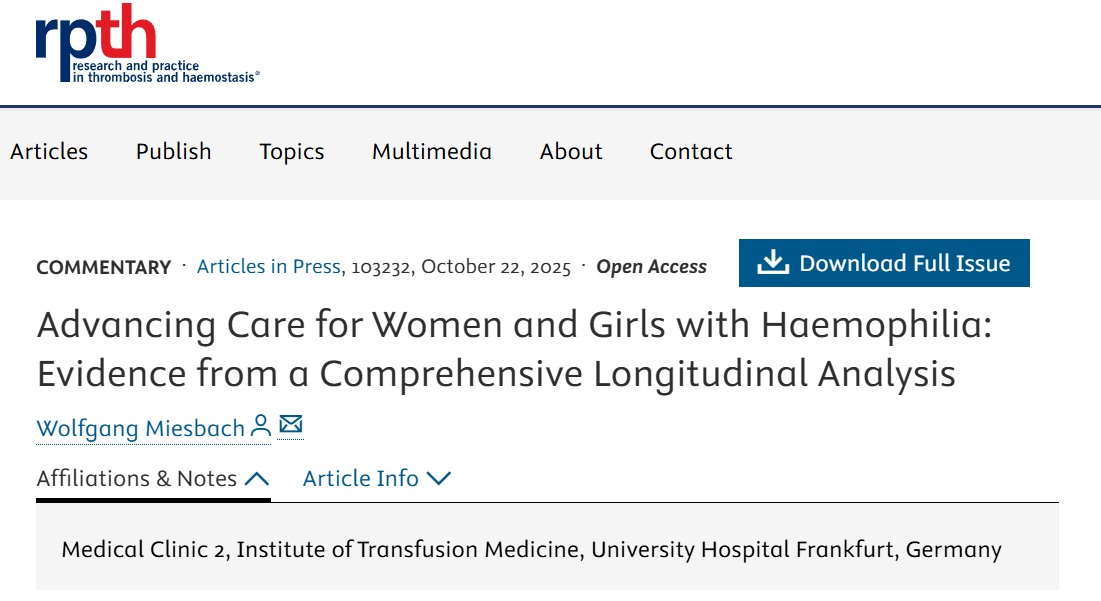
Wolfgang Miesbach: Proud to Share This Commentary Just Accepted in Research and Practice in Thrombosis and Haemostasis
Wolfgang Miesbach, Professor of Medicine at Frankfurt University Hospital, shared on LinkedIn:
“Advancing Care for Women and Girls with Haemophilia. Proud to share this commentary just accepted in Research and Practice in Thrombosis and Haemostasis, contextualising the most comprehensive longitudinal analysis of female haemophilia carriers within the broader evidence base.
Why This Matters Now:
While therapeutic advances (factor replacement, subcutaneous treatments, prophylaxis) have revolutionised haemophilia care, these innovations have not extended equitably to women and girls—marginalised for over two centuries. Despite systematic recognition beginning ~1990, critical gaps persist.
The Evidence Base Converges:
- Dutch qualitative study (Aug 2025): 28 women aged 18–40 revealed that healthcare providers outside HTCs consistently lack knowledge and downplay symptoms, particularly heavy menstruation—causing diagnostic delays and mental health impacts during critical life transitions
- US cross-sectional data: Only 18% of at-risk females access specialised HTCs in well-resourced countries; 7-year diagnostic delay vs males with comparable factor levels persists
- Latest longitudinal analysis (3,663 carriers, 2010–2020): Provides the first systematic lifelong tracking of both factor levels and bleeding symptoms—revealing joint bleeding increases with age (20%→29%→38% across age groups), 50% report chronic joint pain vs 3.3% controls, and most carriers (57.1% HemA, 48.2% HemB) had factor levels >40% yet bled frequently
- Ultrasound studies: Confirm subclinical joint changes even with normal factor levels—paralleling males with mild haemophilia without prophylaxis
Critical Gaps:
<12% use medical alert devices—major safety concern during emergencies
Factor VIII rises with age (↑VWF), yet clinical significance unknown
Prophylaxis use increased (HemB 33% vs HemA 22.7%), yet implementation lags behind need
Guidelines Exist: The article includes a table summarising the linternational guidelines—ISTH 2021, EAHAD/EHC 2021, and NBDF MASAC 2024—that now underpin the standard of care for women and girls with haemophilia and other inherited bleeding disorders.
The Commentary’s Call: Comprehensive risk assessment beyond factor levels, targeted HCP education in and outside HTCs, inclusive clinical research for emerging therapies (extended half-life, non-factor, gene therapy), and systematic medical alert device adoption”
Title: Advancing Care for Women and Girls with Haemophilia: Evidence from a Comprehensive Longitudinal Analysis
Authors: Wolfgang Miesbach

Read full paper here.
Stay informed with Hemostasis Today.
-
Dec 19, 2025, 06:13Anna Aldehag Reflects on Her 12 Year Leadership in Sweden National Board of Health and Welfare
-
Dec 19, 2025, 05:54Abdul Mannan: APTT Mixing Studies Confuse a Lot of People
-
Dec 18, 2025, 23:14The “Normal” FVIII Level Trap in Females with Haemophilia
-
Dec 18, 2025, 23:11WFH Expands Multidisciplinary Bleeding Disorder Training in Vietnam
-
Dec 18, 2025, 17:13Daria Camilli on EuroBloodNet and EHC Collaboration for Bleeding Disorders
-
Dec 18, 2025, 16:50Marie Cambot on Innovhem’s Quantification of The HbF/HbS Ratio for SCD
-
Dec 18, 2025, 16:26Yogesh Rathod on Hematological Issues and ICU
-
Dec 18, 2025, 16:09Carlos Doti: I’m Reminded Why ASH is Such a Powerful Close to The Year
-
Dec 18, 2025, 15:23Michael Hadley: Well-Timed ACC Statement Just Out in JACC Journals
